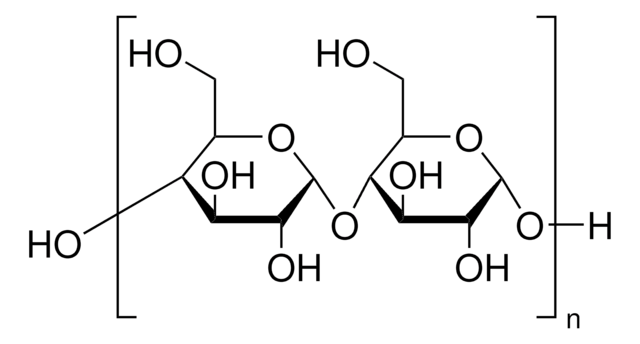S4126
Starch from corn
Synonym(s):
Corn starch, Starch from maize
Sign Into View Organizational & Contract Pricing
All Photos(2)
About This Item
Linear Formula:
(C6H10O5)n
CAS Number:
EC Number:
MDL number:
UNSPSC Code:
12352201
PubChem Substance ID:
NACRES:
NA.21
Recommended Products
biological source
corn
Quality Level
form
solid
color
white
useful pH range
4.0 - 7.0
storage temp.
room temp
Looking for similar products? Visit Product Comparison Guide
Related Categories
Application
Starch from corn has been used:
- in microencapsulation of probiotic bacterial culture(1)
- as a part of model system in sensory analysis of starch-thickened products(2)
- in fabrication of porous silicon nitride ceramic materials(3)
Other Notes
Unmodified regular corn starch containing approx. 73% amylopectin and 27% amylose
To gain a comprehensive understanding of our extensive range of Polysaccharides for your research, we encourage you to visit our Carbohydrates Category page.
wgk_germany
nwg
flash_point_f
Not applicable
flash_point_c
Not applicable
ppe
Eyeshields, Gloves, type N95 (US)
Choose from one of the most recent versions:
Certificates of Analysis (COA)
Lot/Batch Number
Sorry, we don't have COAs for this product available online at this time.
If you need assistance, please contact Customer Support.
Already Own This Product?
Find documentation for the products that you have recently purchased in the Document Library.
Customers Also Viewed
Habibu Aliyu et al.
Frontiers in bioengineering and biotechnology, 8, 226-226 (2020-04-23)
Basidiomycetes populate a wide range of ecological niches but unlike ascomycetes, their capabilities to decay plant polymers and their potential for biotechnological approaches receive less attention. Particularly, identification and isolation of CAZymes is of biotechnological relevance and has the potential
Li Liu et al.
Proceedings of the National Academy of Sciences of the United States of America, 110(14), 5380-5385 (2013-03-20)
Three grinding stones from Shizitan Locality 14 (ca. 23,000-19,500 calendar years before present) in the middle Yellow River region were subjected to usewear and residue analyses to investigate human adaptation during the last glacial maximum (LGM) period, when resources were
E van der Hoeven-Hangoor et al.
Poultry science, 92(10), 2713-2723 (2013-09-21)
Microbiota plays a role in the release and absorption of nutrients from feed components, thereby affecting digesta composition and moisture content of the excreta. The objective of the current study was to determine the effects of 5 different diets varying
Eiji Yamazaki et al.
Carbohydrate polymers, 94(1), 555-560 (2013-04-03)
Effect of the polysaccharide from leaves of Corchorus olitorius L. (PLC) on the freeze-thaw (FT) stability of corn starch gel was studied. PLC was incorporated into the starch gel at 0.7% and total solid was adjusted to 6.0%. The syneresis
Daniëlle Haenen et al.
The Journal of nutrition, 143(12), 1889-1898 (2013-10-18)
Consumption of resistant starch (RS) has been associated with various intestinal health benefits, but knowledge of its effects on global gene expression in the colon is limited. The main objective of the current study was to identify genes affected by
Our team of scientists has experience in all areas of research including Life Science, Material Science, Chemical Synthesis, Chromatography, Analytical and many others.
Contact Technical Service
